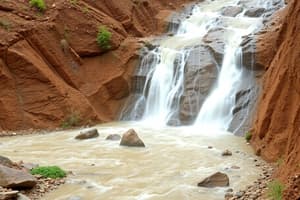Podcast
Questions and Answers
An adverse geologic condition capable of causing damage or loss of property or life is known as a ______.
An adverse geologic condition capable of causing damage or loss of property or life is known as a ______.
geological hazard
Rainfall becomes a magnifier of the impact as it further weakens the ______.
Rainfall becomes a magnifier of the impact as it further weakens the ______.
soil
Satellite mapping helps vulnerable countries to see and evaluate the occurrences of ______ in their area.
Satellite mapping helps vulnerable countries to see and evaluate the occurrences of ______ in their area.
landslides
Areas holding a certain degree of steepness may cause landslides when encountering heavy ______.
Areas holding a certain degree of steepness may cause landslides when encountering heavy ______.
Understanding the manner of its failure is just as important as understanding its ______.
Understanding the manner of its failure is just as important as understanding its ______.
One mode of failure of landslides is ______.
One mode of failure of landslides is ______.
To mitigate landslide risks, communities often utilize maps to identify potential ______.
To mitigate landslide risks, communities often utilize maps to identify potential ______.
During a landslide, it is important to stay alert and be ready to move away from the path of the ______.
During a landslide, it is important to stay alert and be ready to move away from the path of the ______.
Assessing the area using hazard maps is one of the actions to take ______ a rainfall-induced landslide.
Assessing the area using hazard maps is one of the actions to take ______ a rainfall-induced landslide.
Increased turbidity of water can be a sign of an impending ______.
Increased turbidity of water can be a sign of an impending ______.
The culprit here is the generation of ______ acids as these acids act to dissolve the rocks.
The culprit here is the generation of ______ acids as these acids act to dissolve the rocks.
Typhoons originate mainly near the ______ due to the presence of warm air and trade winds.
Typhoons originate mainly near the ______ due to the presence of warm air and trade winds.
For a typhoon formation to occur, there should be a sufficiently large warm ocean with at least more than ______ in temperature.
For a typhoon formation to occur, there should be a sufficiently large warm ocean with at least more than ______ in temperature.
The mass of air becomes convectively unstable and ______ compared to its surrounding air according to the Convective Theory.
The mass of air becomes convectively unstable and ______ compared to its surrounding air according to the Convective Theory.
To communicate with experts for land assessment, one should also check with a nonlife ______ company to see if damages are covered.
To communicate with experts for land assessment, one should also check with a nonlife ______ company to see if damages are covered.
Stay clear of the slide area as additional ______ may come.
Stay clear of the slide area as additional ______ may come.
According to the USGS (2018), a sinkhole is an area of ground that has no natural external surface ______; hence, when water dissolves surface rock, a hole is formed.
According to the USGS (2018), a sinkhole is an area of ground that has no natural external surface ______; hence, when water dissolves surface rock, a hole is formed.
Both cover-collapse sinkholes and gradual cover-subsidence sinkholes are caused by ______.
Both cover-collapse sinkholes and gradual cover-subsidence sinkholes are caused by ______.
Heavy rainfall and man-made activities are also major factors that contribute to the exposure of the ______ to elements.
Heavy rainfall and man-made activities are also major factors that contribute to the exposure of the ______ to elements.
Dissolution and ______ are 2 processes that create 3 types of sinkholes.
Dissolution and ______ are 2 processes that create 3 types of sinkholes.
Flashcards
Rainfall-Induced Landslides
Rainfall-Induced Landslides
Landslides triggered by heavy rainfall, which weakens soil and rocks, leading to slope failure.
Slope Steepness
Slope Steepness
The angle of a hill or mountain, a crucial factor in landslide occurrence, as steeper slopes are more prone to failure.
Weakening of Slope Materials
Weakening of Slope Materials
Heavy rainfall can erode and weaken soil and rocks, reducing their ability to hold the slope together, increasing the risk of landslides.
Overloading on the Slope
Overloading on the Slope
Signup and view all the flashcards
Landslide Failure Types
Landslide Failure Types
Signup and view all the flashcards
Sinkhole
Sinkhole
Signup and view all the flashcards
Dissolution
Dissolution
Signup and view all the flashcards
Carbonate Bedrock
Carbonate Bedrock
Signup and view all the flashcards
Suffusion
Suffusion
Signup and view all the flashcards
Cover-Collapse Sinkhole
Cover-Collapse Sinkhole
Signup and view all the flashcards
Early Warning System (EWS)
Early Warning System (EWS)
Signup and view all the flashcards
Mitigation Strategies
Mitigation Strategies
Signup and view all the flashcards
Slope Movement Monitoring
Slope Movement Monitoring
Signup and view all the flashcards
Carbonic Acid's Role
Carbonic Acid's Role
Signup and view all the flashcards
Sinkhole Formation
Sinkhole Formation
Signup and view all the flashcards
Typhoon Formation
Typhoon Formation
Signup and view all the flashcards
Convective Theory
Convective Theory
Signup and view all the flashcards
Typhoon Dynamics
Typhoon Dynamics
Signup and view all the flashcards
Study Notes
Extreme Weather Preparedness
- Keep emergency kit (snow shovels, firewood, clothing)
- Listen to local radio for weather updates
- Stay indoors to minimize travel
- Change wet clothing to prevent heat loss
- Maintain proper ventilation (avoid kerosene heater/coal fumes)
- Seek shelter if power/heat lost
- Watch for frostbite symptoms (numbness, pale skin)
- Wear warm, layered clothing to protect from frostbite/hypothermia
Geological Hazards (Landslides)
- Landslides are adverse geologic conditions causing damage/loss of life
- Rainfall is a critical factor, impacting slopes and soil
- Satellite mapping helps assess vulnerable areas
- Slope instability, weakening of soil, and overloading are key causes
- Landslides are multi-factorial and vary by region
- Failure modes include falling, toppling, sliding, spreading, and flowing
- Factors affecting landslides include soil composition and rainfall frequency
Mitigation Strategies (Landslides)
- Avoid construction in hazardous areas (steep slopes, drainage paths)
- Understand local geological risks using maps
- Be aware of signs of danger like water flow changes, shifting or unstable ground
- Implement early warning systems for communities
- Prepare individual emergency response plans
- Minimize home-related hazards
- Stay alert and move away from hazardous areas during extreme weather
- Be updated on mitigation progress and possible threats
Sinkholes
- Sinkholes are ground collapses occurring beneath the surface
- They occur in areas with dissolved bedrock (dissolution/suffusion)
- Water and carbon dioxide create carbonic acid that dissolves carbonate bedrock
- Sinkholes may be slow or rapid in their collapse
- Manmade activities can expose areas to greater risk of sinkholes
- Take measures to avoid areas where they appear (leave the area, warn others)
- Monitor and communicate with experts in these cases
Typhoons
- Typhoons form over warm ocean water, from rising warm air which is drawn into the storm, which needs to be understood as the subsequent hazards from this event.
- They are associated with high winds and heavy rainfall.
- Four life stages: formative, immature, mature, decaying.
Heat Waves
- Heat waves involve prolonged periods of abnormally hot weather.
- Impacts include skin cancer, headaches, dehydration, heat stroke, and heat exhaustion
- Prepare by installing fans, checking for proper insulation surrounding air-conditioning devices, or use alternatives.
- Wear light-colored, loose-fitting clothing
- Drink plenty of water, even when not feeling thirsty
Studying That Suits You
Use AI to generate personalized quizzes and flashcards to suit your learning preferences.




